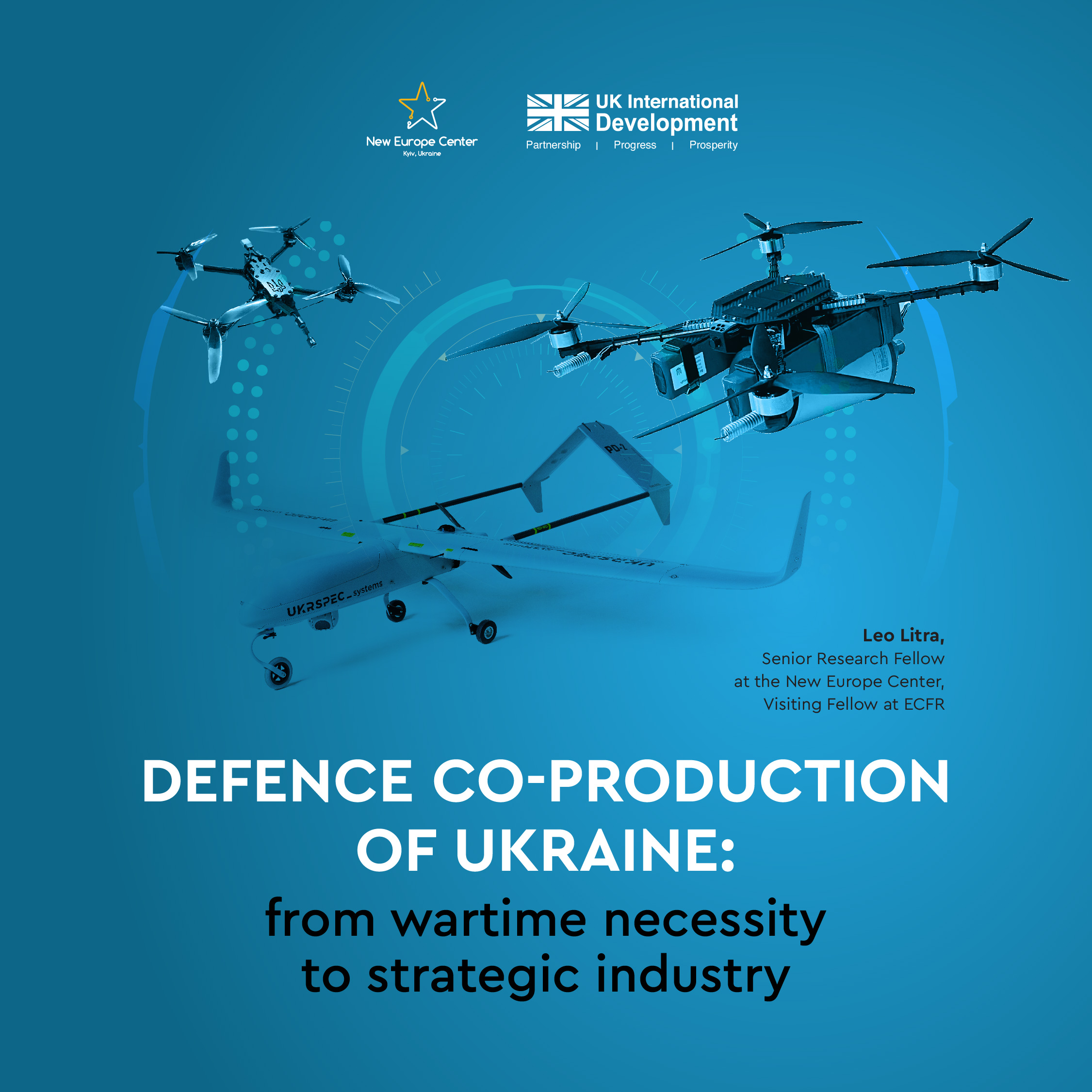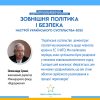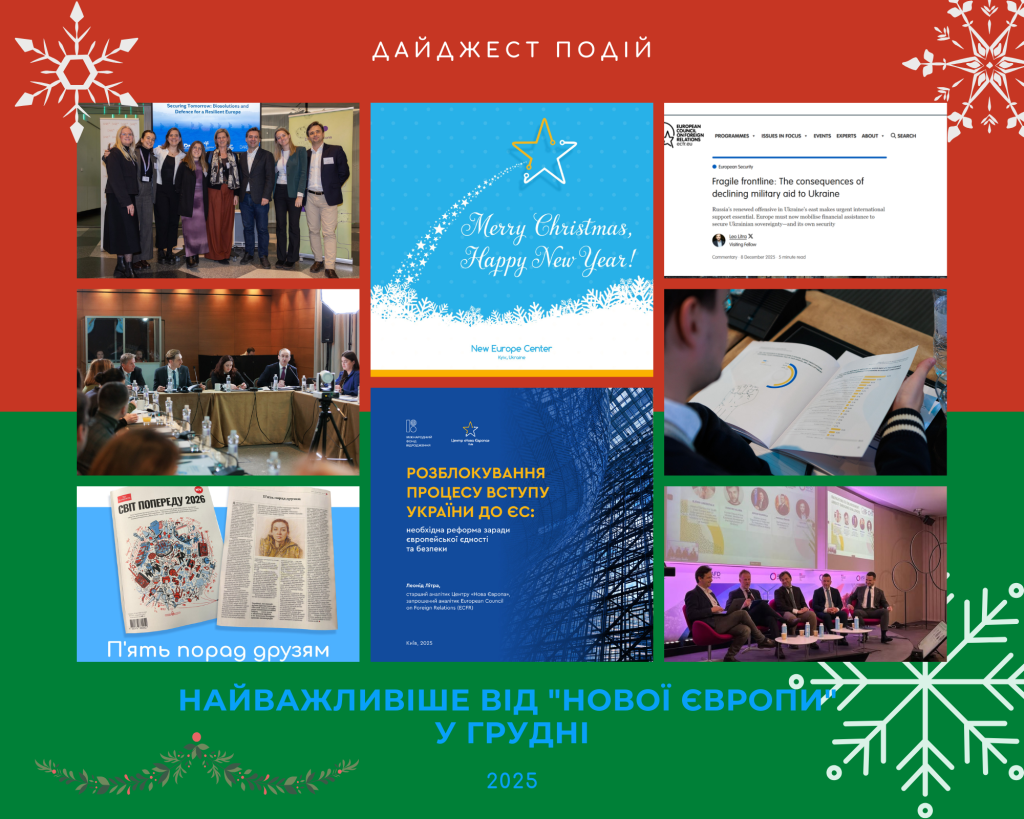
The analytical material was presented during the discussion “Arms production investments. Are Western partners ready to strengthen Ukraine’s defense capabilities?” on September 5, 2025 in Kyiv. The event was organized by New Europe Center in partnership with “National Interest Advocacy Network “ANTS” NGO.
PDF-version of the document is here.
Since 2022, Ukraine has shifted from near-total dependence on Western arms to producing 40% of its defence needs by 2025. International co-production coupled with Ukraine’s rapidly growing battlefield-driven innovation—specifically in drones—has made it a global champion in adaptive defence technologies. Major players like Rheinmetall and KNDS are investing, EU and national funding schemes support expansion. Underinvestment, bureaucracy, corruption risk, lack of labour, and Russian attacks slow progress. In order to make it sustainable, Ukraine must institutionalise co-production, expand controlled exports, and integrate into EU/NATO defence systems, translating wartime necessity into a strategic industry for the long-term.
Intro
When the Russian large-scale aggression against Ukraine started in 2022, Kyiv’s survival depended on the military aid provided by its Western partners. However, as the war evolved, the reliance on military assistance from Ukraine’s partners showed Kyiv how volatile and uneven the process could be. Already in late 2023, the prolongation of the US military assistance to Ukraine was called into question, and the supplies from the European partners decreased due to the fast usage of stockpiles. That was the moment when Ukraine realised, contrary to its previous assumption, that the future of military assistance is uncertain and Ukraine’s defence is extremely vulnerable. The only way to address the issue systemically and coherently was to start production of military items at home, which meant to shift from passive assistance dependence to industrial cooperation and partial self-reliance. That entails not only receiving weapons and spare parts, but also co-producing them.
Ukraine’s co-production of weapons showed a significant increase. According to official data, in 2025 Ukraine will produce about 40% of its needs, including through co-production, up from 10% in 2022. The jump is substantial but would have been impossible without the cooperation of its partners, above all the funds coming to meet the enormous demands of the military industry. To move from an ad-hoc joint production to a well-planned and integrated format of co-production, it will take an immense effort to deliver fast, massive and cutting-edge technology to roll back the Russian aggression. As of now, despite the increasingly heated debates about the joint production, the actual level of joint production is still in the inception phase.
Engines of co-production: partnerships, innovation and funds
2.1. Partnerships
The resistance of Ukraine and the further rollback of Russian occupation in 2022, as well as the understanding that the war will be a lasting one and Europe is not safe in the coming years, made some global producers state their interest in creating joint production in Ukraine, with Ukraine, or for Ukraine.
Most of the co-production since the very beginning is following a model with a top-down approach. The governments of partner countries allocate the funds and then a joint company is created in Ukraine to produce military items. However, despite the progress in setting up the first companies and already delivering results, there are only a handful of companies that could be listed. In most of the cases, despite big production plans, the companies that have been created to co-produce military items are in fact dealing with maintenance and spare parts. There are also other ways of co-production, spread much wider within Ukraine, when partners’ money is used to place orders for drones and other weapons. Funding Ukrainian producers has been very successful, both in terms of outcomes and in terms of efficiency. This is how Ukraine managed to produce nearly 2 million drones in 2024.
The community of drone producers are asking the authorities to lift the ban on military exports, so that they can maintain their scale and attract new funds. The main problem, according to drone producers, is that Ukraine cannot place enough orders to satisfy the production capacity of the companies. At the same time, Ukraine wants to make sure that it has enough for its own use, and once the ban is lifted, it will not have challenges in getting drones. This question is a fine line to walk since on the one hand the state thinks of its reliability and export control, while on the other hand, some drones might lose their technological advantage if they don’t sell and thus continue their innovation cycle. Certain sources in the government of Ukraine claim that only a few companies would be able to be competitive if the ban is lifted and therefore, the problem is a bit exaggerated. Nevertheless, the authorities are looking for a legal mechanism to grant permission to relocate production abroad provided that most of the production comes to Ukraine.
As of the beginning of the large-scale invasion, a handful of companies managed to set up co-production in Ukraine. Turkish Baykar was the first to announce a plant for UAV production, however, this has not yet been fully settled to date. German Rheinmetall was the first to set up a joint venture in Ukraine, together with a Ukrainian state enterprise, in 2023. The company initially repaired Leopard tanks, Lynx IFVs, and other German-origin equipment. It also created a centre of excellence for the production of the 155 ammunition, aiming to launch a full-fledged facility in Ukraine. Similar to Rheinmetall, the French-German KNDS launched a facility to produce spare parts and ammunition for Leopard tanks and Ceaser howitzers. The US Northrop Grumman signed a co-production agreement in mid-2024 that aims production of ammunition. Other countries, such as Norway’s Nammo and Sweden’s Saab, are also developing their production in collaboration with Ukraine. A few countries, like Denmark, are hosting Ukrainian production on their soil for the reasons of security. All these projects, alongside with other projects in development, are signalling a big development push for the defence industry of Ukraine.
2.2. Innovation
The ability to test the defence production in real conditions in real time in Ukraine made, as put it by a MoD official, “a land of opportunities”. The West had an upper hand in producing advanced technological weapons, but many of these were never tested in real war conditions. For instance, it was a great revelation in May 2023 to find out that Russia’s Kinzhal hypersonic missiles, portrayed as unstoppable, were intercepted by Ukraine’s Patriot system. The same goes for the use of German self-propelled artillery Panzerhaubitze 2000, which had barrels with an assessed lifespan of 4500 shots, but it proved that it can go up 4 times more.
If the knowledge about the classic military equipment has been strong in many countries operating the equipment, then in the operation of drones, Ukraine has been a champion. In 2025 Ukraine will produce between 3-4 million drones, although it is able to produce about 8 million each year. The use of drones in the Russia-Ukraine war and their possibilities served as a wake-up call for many countries, including the US, to develop a new industry aimed at cheap and expandable drones. Over the years of the large-scale war, there have been many turning points that proved drones as one of the key weapons for the future. But the Spiderweb operation, in which 117 cheap drones under $1000 have been used to damage or destroy one third (41 planes) of the Russian strategic aviation worth 7 billion, is by far the most significant. The Spiderweb operation is the world’s largest special force strike in history, with effects that go beyond the Russia-Ukraine war. It marks the shift from an attrition-based warfare into an asymmetric, decentralised and technologically sophisticated operations that underline the capacity of the enemy far from the frontline.
For the small FPV drones the innovation is not least important. Ukraine’s armed defence forces provide instant feedback to drone producers on the shortcomings and possible improvements. In many cases, the producers operate updates in a matter of days and even in a matter of hours, which allows Ukraine to keep its competitiveness in the drone industry.
The R&D financing budgets for Ukrainian producers have been significantly smaller than the budgets of companies that are producing fewer and untested weapons. The war and the necessity to be agile are the engines of Ukrainian innovation. Ukraine has been trying to mobilise support through the establishment of Brave1 innovation cluster in 2023 which now supports around 600 startups operating in drones, AI, electronic warfare, robotics, etc. It also launched the “Test in Ukraine” program which allows foreign producers to legally test their weapons in Ukraine.
The innovation and know-how of Ukraine in operating weapons and new systems in real war conditions and the database is the main ‘currency’ of Ukraine, as confessed by an MoD official. The innovation without testing and without being able to give real-time feedback as well as the ability to operate these in war conditions. This is by far the main asset and argument why the producers of weapons should have Ukraine on board and develop joint projects.
2.3. Funding
The economics of Ukrainian defence production is the topic with the biggest attention now. Ukraine falls short of money to fund its defence industry and the main topic when discussing defence cooperation with its partners often narrows down to funding of defence production.
At the beginning of the large-scale war, partners relied on ad-hoc donations of weapons to Ukraine rather than ramping up production. The decades of disinvestment in the defence sector, especially in Europe, made the West realise that they are significantly lagging behind Russia and its allies, which makes them extremely vulnerable in the face of a potential larger war. To put things into perspective, one needs to underline that North Korea alone was able to supply more ammunition than Europe together. About 40% (5.8 million rounds) of the ammunition needs of Russia have been provided by North Korea which not only kept Russia in the war but arguably changed the course of the war. The US and Europe together managed to provide the same amount as North Korea. At the same time, the production capacity of artillery rounds in Russia outruns Western capacity by 3 times.
The only response of the West to address the growing difference was to put in place financial instruments to increase the production capacity. At the beginning of the large-scale war, the instruments were rather reactive. For instance, a significant amount of EU support to Ukraine was channelled through the European Peace Facility. In the context of Ukraine, the EPF was designed to address three directions of support: reimbursements of the existing stocks for countries donating weapons to Ukraine; joint procurement orders; and scaling industrial production.
But as the war turned into a war of attrition, the EPF, other smaller programs and donations from existing stockpiles could no longer address the critical issue of production capacity. In this context, the European Union put together the ReArm Europe program aimed to make 800 billion euros available until 2030. The program helps to unleash public funding in the defence sector, carry out urgent and massive defence investments in production capacity and mobilise the private capital. The Security Action for Europe (SAFE), worth 150 billion euros is an excellent instrument that allows investments in defence production based on loans to member states backed by the EU budget. Most importantly, the SAFE mechanism covers Ukraine as well, which means that collaborative projects can be funded under SAFE provided that there is at least one EU country. It can be assumed that SAFE will address one functional issue – the fragmentation of the EU defence base. Therefore, collaborative projects will stimulate integration and joint orders and production.
Based on the current scheme of funding, one can mention that the strategy adopted by the EU and the overall direction are correct and aimed at solving the defence production problems. However, the biggest weaknesses remain the speed and scale. Speaking at the NATO Public Forum in The Hague, Polish foreign minister Sikorski mentioned that “Russia awoke a giant” – meaning that the EU can mobilise enormous resources and once the EU machine is turned on, the impact will be tremendous. However, the giants are powerful but not fast. Regulations are far more complex and prices are much higher than those in Ukraine. Certain experts assume that the desire of foreign companies to produce defence-related goods in Ukraine is precisely driven by the low prices and huge opportunities that the current war offers.
The lack of funding for Ukraine-based production made the government and its partners think of new instruments. The so-called “Danish model”, which started with a 50 million euros investment into Ukrainian defence production through the MoD of Ukraine, proved to be a robust instrument that delivers fast and supports Ukraine’s domestic production, which is critical for the current state of affairs. According to the Danish defence ministry, about $550 million were funded in 2024 through the “Danish model” and in 2025 the amount shall exceed $1 billion. All this money has been provided by several countries, including the EU, through the windfall profits from the frozen assets.
Denmark has also been innovative by offering a guarantee scheme for companies wishing to invest in the defence and security of Ukraine with reduced financial risks. The guarantee scheme can cover up to 70% of investments, which makes it much easier to take the risk of opening a business related to defence in Ukraine. In exchange, the Danish companies will get the latest technologies, operational experience and access to testing in combat.
Those who do not want to channel their funds through the Ministry of Defence of Ukraine have the opportunity to use the so-called Dutch model, which involves direct funding for Ukrainian companies producing defence-related goods.
All the instruments and models available have the capacity to build a very strong industry in Ukraine and create the best tested weapons in real war conditions. However, 3.5 years after the large-scale war, the Ukrainian industry was heavily underinvested. Out of the $35 billion capacity, only a third of it is currently having production contracts.
One of the few funding mechanisms that can address all the issues related to the availability of funds is the confiscation of the Russian frozen assets. So far, the main European stakeholders have decided not to proceed with the confiscation, still hoping that the issue can play an important role in the settlement of the war. If the confiscation will indeed be ignored, then a decent alternative should be focused on making co-production a part of the security guarantees for Ukraine. Currently, the discussion over the security guarantees is in an active phase of debate. Making guaranteed co-production a pillar of the security guarantees can significantly address some of the main challenges, such as funding.
Challenges and bottlenecks in developing a full-fledged defence industry
The funds for the development of the defence industry appear to be the biggest problem yet to be solved. At the same time, several issues not related to money stand aside when it comes to the increase in investments in the production of defence goods in Ukraine. One can divide these into military and non-military.
3.1. Military challenges
By far the most significant military challenge to locating defence production in Ukraine has been the constant Russian attacks on the production sites. The answer of Ukraine was straightforward – decentralising the production of defence goods and the acquisition system. Production of drones has been taking place not only in small factories but also in makeshift offices where a few people would assemble drones. Even more, spare parts for assembling drones were made available to people who wish to assemble drones which is not rocket science and the equipment is available at home.
The air defence of Ukraine has covered larger production sites, although under the massive Russian attacks, the damage was often inflicted. This also stimulated the changes in the legislation which turned into a very flexible acquisition system. Aside from centralised acquisitions, military units were allowed to buy military items directly from the state budget, local budget or from volunteer donations. That enhanced high adaptability to real-time battlefield challenges.
The security of investments in the defence production of Ukraine is one of the main questions to be answered before the investment plans are made. Overall, the interviews pointed out that currently, many companies are hesitating to invest in Ukraine due to high security risks. The strike on the Baykar plant showed how vulnerable these investments can be, especially for larger plants. That is why a number of initiatives to provide guarantees for investments have been put in place by certain member states and by the EU. Yet, that did not change the overall trend of cautiousness in defence investments in Ukraine.
The security dimension is closely linked to the energy sector. The attacks on the grid and strained logistics are undermining the continuity of production and increasing operating costs. Since the winter of 2022/2023, Ukraine has gone through a very difficult but transformative process that resulted in higher resilience of energy infrastructure, especially the electricity grid. The cancellation of taxes for batteries and renewables, as well as the exceptional amount of donations of generators and other off-grid systems, has reduced the critical impact of the energy grids.
The physical risks that discourage private capital from investing are reinforced by the fears that the war could be over soon and a demand collapse can happen anytime after the cease-fire. To address this issue, one needs to create post-war transition plans with a specific focus on dual-use conversion of goods. Also, certain officials mentioned that the state should be ready to off-take post-conflict critical production lines, and that could be one of the clauses of the contracts.
3.2. Non-military
But even if we assume that Ukraine has a 100% air-defence rate of success and all the investments are backed up by guarantees, that does not solve the problem entirely. The issues of corruption, bureaucracy and human capital stand out as risks often portrayed as greater than the military ones.
In August 2025, the head of Rheinmetall criticised Ukrainian bureaucracy for slowing down the construction of an artillery ammunition plant in Ukraine. To put things into perspective, one needs to mention that a similar plant was launched simultaneously in Germany and has already been completed. Ukrainian officials floated the idea that Rheinmetall is lagging behind its own unrealistic schedule, and that is why the statement came to cover their own delays. The problem, however, is that this is by far not a singular case when Ukrainian administrative hurdles create additional headaches for the investors in Ukraine.
The bureaucracy problem is often entangled with the corruption issue, mentioned regularly by EU officials in off-the-record interviews. All the cases of inflated prices for food for the AFU, as well as other corruption cases involving the purchase of drones or spare parts for specific production, created a negative background for investments. Also, cases of rigged contracts with kickback schemes were in place on several occasions. The latest case involved corruption in the procurement of drones and jamming systems, with kickbacks amounting to 30%.
At the same time, one needs to underline that there has been no corruption identified in the contributions made by the foreign partners. The biggest effort in auditing the military support was undertaken by the Pentagon Inspector General, who in late 2024 mentioned that, up to June 2024 that no irregularities were noticed on the funds spent on Ukraine. At the same time, 57 investigations were opened involving possible cases of corruption from funds coming from sources other than the US (likely Ukrainian budget).
The inflation of prices appears to be also common in the military aid provided by the US. The audit of the PDA (Presidential Drawdown Authority) showed that $6.2 billion and $5.7 billion were missing cost estimates.
The corruption cases, which were identified and had a significant impact in the public space, triggered the reform of the procurement system. That widely resulted in separating lethal procurement which was operated by DOT (State Logistic Operator) and DPA (Defence Procurement Agency). Despite the scandal of changing the leadership of the DPA, both institutions managed to provide results in saving costs and increasing the rate of delivery.
One can mention that the corruption scandals have been an engine of reforms in Ukraine. Following the reform of the procurement system, the Ministry of Defence adopted an anti-corruption program which, among other things, increases the transparency of procurement mechanisms and quality assurance, implements electronic fuel monitoring, initiates audits, etc. These efforts are backed by the National Agency for Corruption Prevention, which together with NATO and defence institutions, implements NATO-aligned procurement standard implementation. This involved the creation of supervisory boards and improved oversight mechanisms, establishing compliance tools, creating a single vendor registry, and establishing blacklist criteria. The situation is far from being good, despite improvements, which raises concerns among Ukraine’s biggest donors.
The non-military challenges don’t end here. The shortage of a qualified workforce is making the industry more vulnerable, which, in combination with stable contracts, creates additional roadblocks in absorbing new technologies and expanding output at scale. The war has depleted a significant portion of the skilled labour force, either through mobilisation or emigration. To this end, defence producers find it more difficult to hire engineers, technicians, specialists in AI, cybersecurity, robotics, etc. A drone producer has been complaining that Russia has deliberately attacked engineers or certain companies, since the elimination of the key engineers can have a deadly impact on the product.
This is strongly connected with the need to have a systemic planning of the post-war transition. Even though currently Ukraine has made speed and volume an absolute priority of the war, it will have to consider how the industry can convert wartime production into civilian-military dual-use goods. Without such planning, there is a risk of overcapacity and the collapse of a part of the industry after the war, which can seriously discourage any long-term investments.
Conclusions
Ukraine’s path from near total dependence in 2022 to almost 40% of domestic production today is a powerful move that shows both resilience and adaptability. The vulnerability of relying on the political will of the partners and their stockpiles pushed Ukraine into co-production and expansion of its industrial sector. Although the results on co-production remain limited so far, Ukraine has demonstrated its ability to mobilise resources and leverage its advantage in innovation, which stimulated interest from leading world companies in defence production.
The defence co-production track is not only a war necessity but it is a foundation of strategic industry with long-term implications for the integration with the European and Euro-Atlantic defence sector. Ukrainian innovations with real-time battlefield testing, instant feedback between the military and producers as well the scale of production, position Ukraine as a leader in certain technological areas. This is an asset of global importance since it offers Ukraine’s partners the possibility to test their systems and access to innovation cycles unrivalled elsewhere.
Yet the industry faces major bottlenecks. Bureaucracy, corruption risks, financial constraints and security threats are seriously undermining investments in the sector. The funding models, such as the Danish and Dutch models, have shown potential and help Ukraine and its industry; however, these still remain small compared to Ukraine’s needs. At the same time, instruments such as SAFE are powerful but slow in providing results. Without significant funding, Ukraine’s defence industry risks a crisis with irreversible consequences.
Overall, Ukraine stands at a crossroads. Ukraine has demonstrated its ability to innovate, produce, and fulfil much of its own defence needs. To realise wartime ad hoc effort as a strategic, export-driven sector, however, Ukraine and its supporters must remedy the structural underfinancing, governance defects, and investor uncertainty. The future of Ukraine’s defence industry will not just rely on wartime imperatives, but also on the institution of reforms, mobilising large-scale investment, and integration into wider NATO and EU industrial systems.
Recommendations
- Streamline the co-production environment
What to do: establish a single window or an office with authority to coordinate permits, customs clearance, land use, connection to critical infrastructure and procurement approvals for investors in defence.
Why it matters: current bureaucratic hurdles have already delayed certain projects. Every delay is reducing Ukraine’s ability to increase its defence production and thus making it more vulnerable. Streamlining legal procedures would increase investors’ confidence and demonstrate more seriousness to partners.
How:
- introduce legally binding deadlines for the paperwork on co-production projects;
- adopt a single window approach so that investors deal only with one entity;
- ensure compatibility in the procurement and certification process between Ukraine, the EU and NATO.
Expected impact: a higher trust from investors, greater inclusion of Ukraine into the EU/NATO defence ecosystem, and faster implementation of the projects.
- Scale defence co-production through controlled export flexibility
What to do: speed up the creation of a legal framework for the export of defence goods produced in Ukraine.
Why it matters: certain producers, especially the drone ones, currently face overcapacity since they do not have enough contracts. Without the exports, the innovation cycles stall and the companies face significant challenges. Despite the announcement of President Zelenskyy of the “Build with Ukraine” program meant to establish production lines abroad, this is a top-down approach that prevents scale and does not allow companies which are only Ukrainian-based to get involved.
How:
- open the possibility for all defence producers to establish production lines abroad in countries that signed security agreements with Ukraine;
- clearly define a quota for supply to Ukraine (eg. 80% of production) while the rest for export under license;
- establish an innovation exemption that would allow immediate export of the next-generation system in order to preserve the technological competitiveness, provided that the domestic needs are met.
Expected impact: increased capital flow, sustained innovation and avoidance of contraction of defence production. That would also strengthen the position of Ukraine as an exporter and not a consumer only.
- Make co-production a pillar of Ukraine’s security guarantees
What to do: embed co-production into the security guarantees framework of Ukraine. Portray joint production as a support for Ukraine but also as a reinforcement of the transatlantic security.
Why it matters: donations and ad-hoc security aid are subject to political volatility – see the US case. Joint production provides resilience, predictability and shared ownership. For Ukraine’s partners it diversifies the production base while for Ukraine it leverages Ukraine’s battlefield tested innovation.
How:
-establish a guaranteed number of joint ventures in Ukraine and abroad as part of long-term defence planning.
-earmark funds through SAFE, bonds, or newly designed programs to fund agreed projects
-update security agreements with a clause on co-production
Expected impact: Ukraine becomes an integral part of the Euro-Atlantic defence base, partners gain access to unique, battlefield-tested innovations, and production bottlenecks in Europe are reduced.
- Hybrid co-production backed by fast-track funding and guarantees
What to do: combine split production models with producing sensitive components abroad and assembling and testing in Ukraine with donor-backed guarantees
Why it matters: purely Ukrainian companies face high security risks, while purely foreign companies undermine the Ukrainian companies.
How:
- expand Danish-style guarantee schemes by covering a significant amount of risks;
- use Dutch-style funding for Ukrainian projects;
- establish transparent oversight by creating boards from both sides and the donor.
Expected impact: Ukraine strengthens its industrial base without absorbing all the risks, companies gain the confidence to invest more in Ukraine, accelerated integration into the supply chains of NATO/EU countries and ensures a balanced wartime urgency with post-war sustainability.
This material was funded by the UK government as part of the “Mutual Transformative Power: changing Ukraine through cooperation with wider Europe” project, implemented by the New Europe Center. The views expressed in this material are those of the author and may not coincide with the official position of the UK government.







